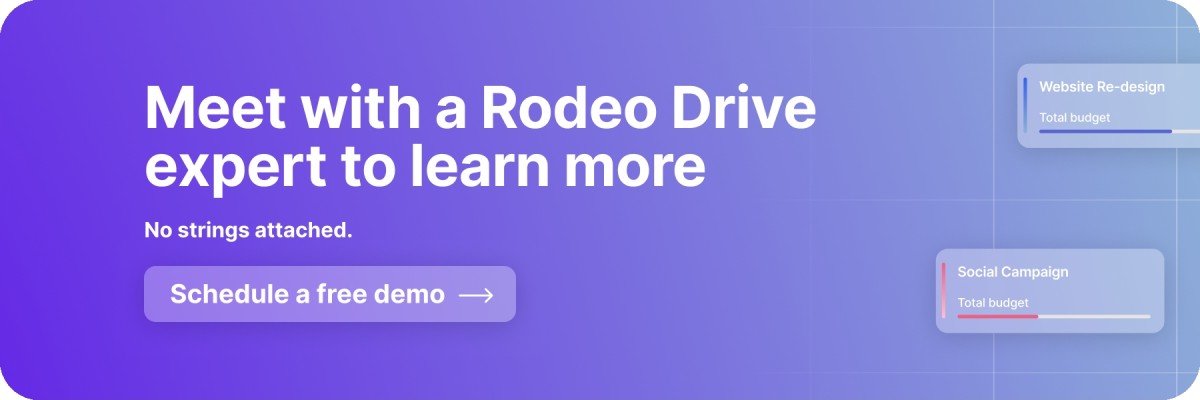How to Write a Clear and Concise Creative Brief
If you’ve ever completed a creative project only to realize that your client is dissatisfied with the final product, then an insufficient creative brief is likely to blame.
Compiling details on the client’s vision for the project can improve alignment and produce better outcomes. The creative brief is the document that will illustrate the client’s wants and needs so your team can execute them accordingly.
Without a creative brief, you might end up with deliverables that aren’t in line with the client’s branding or the campaign messaging.
Luckily, this article will walk you through what a creative brief is, as well as the process of making one. This way, your creative team will always have a crystal clear understanding of the project vision right from the get-go. Let’s begin.
What’s a creative brief?
A creative brief is a short document that outlines the objectives, target demographics, messaging, and other main details of a creative project.
Creative projects usually involve out-of-the-box thinking that captures the audience's attention in innovative ways. Many marketing projects and advertising campaigns fall into this category.
They include a wider range of creative stakeholders than a typical project, and the creative brief ensures that your team of marketers, designers, and copywriters are working toward the same creative outcomes.
That’s why creative briefs are used to ensure alignment with the project mission and ensure that the project team fully understands the client’s vision for the project.
Benefits of creative briefs
Aside from providing visual instructions and guidelines for the project, a creative brief also ensures everyone involved in a project is aligned on expectations, objectives, and deliverables. When writing one, you’ll also be able to better visualize and articulate the scope of the project.
On the agency side of things, you want to have all of the right information to deliver what the client is looking for, and a creative brief is one of the best ways to ensure just that. More often than not, a poor creative brief is to blame when the client is unhappy with the results of a project.
Creative briefs lay the foundation for what the project will accomplish, save you time by avoiding misunderstandings later on, and pave the way for high-quality deliverables that are up to the right standards.
Who’s responsible for compiling the creative brief?
The question of who’s in charge of the creative brief might depend on the nature of your organization. If you work for an agency, you might find that the person who manages the client relationship is responsible for the creative brief, which may be the account manager or project manager.
Although it may seem easy to send a creative brief template to the client for them to fill out on their own, this isn't advisable. Allowing the client to tackle this process by themselves can take too long, cause frustration, and create misunderstandings.
Instead, the creative brief should be developed in a meeting between the client and agency representatives. This meeting should happen during the project initiation phase, as the creative brief will need to be created before any work starts.

Including the creative director in the conversation will also be helpful to guarantee that the client’s wishes are feasible and that everyone is on the same page regarding project requirements.
Once the project manager or account manager has written the creative brief, they should send it to the client as a way to summarize their conversation and confirm that everything is correct before they begin the project.
Related: Client Management: Best Practices for Building Strong Relationships
When to use a creative brief
As you might expect, creative briefs are typically used in projects where there is a lot of leeway as to how the creative agency or team might interpret the client’s wishes.
Advertising and marketing teams usually rely on creative briefs more than other teams due to the highly creative nature of their work. Here are a few examples of the types of creative projects that might require a creative brief:
- Redesigning a client’s product packaging
- Creating a promotional video
- Launching a seasonal marketing campaign
- Building a new website design
But that isn’t to say that a creative brief is needed for every single project your agency encounters. In fact, for very standard and routine projects, devising a creative brief might actually be a waste of time.
Creative agencies can classify their projects into one of three tiers to determine whether a creative brief is necessary to guide their project and how robust it should be:
- Tier 1 — Highly conceptual, non-standard work: Because highly conceptual work has a lot of room for ambiguity, a brief is necessary to nail down what the client wants. Without documented guidance, it’s usually too difficult for creative team members to know whether they’re headed in the right creative direction when working on Tier 1 projects.
- Example: If a company wants to completely overhaul and redesign its brand identity, a creative brief is essential to define the brand personality, target audience, and emotional response that they’re looking for.
- Tier 2 — Projects based on previous work: Tier 2 projects are based on work that’s already completed, meaning that creative briefs do not need a ton of detail since they’re based on previous work.
- Example: A website redesign would be considered Tier 2 work, as the creative team already has the existing design and structure to work with. Therefore, the creative brief will just need to focus on specific aesthetic updates and content improvements.
- Tier 3 — Templated work: This type of standardized work is very straightforward, and does not require anything more than a project description. A creative brief is not necessary.
- Example: An email newsletter that’s distributed monthly may be considered templated work since most newsletters typically contain standard sections like updates, promotions, and other news. This set structure typically eliminates the need for creative briefs.
Essential components of a good creative brief
There’s a lot of information that could fit within a good creative brief, the question is what information is worth including.
What you will include also depends on the scope of the project and the purpose of the brief. Although it should by no means be used as an exhaustive list, the following components provide an overview of the information that’s most important to include.
You’ll find that the following elements are oftentimes the most impactful in terms of the direction of the project. As such, you’ll want to dedicate enough time to each.
1. Project and client background
Most agencies work with several clients at a time, which makes the client background component of your creative briefs especially essential. On the other hand, in-house teams won’t need this sort of context, unless there are freelancers and other external parties involved in the project.
The background section of your creative brief should also provide insight into the project background, including previous company activities that might be related to the project. Context on the client’s branding is also beneficial to include in this section.
For example, ask questions about whether the client has launched similar campaigns before, whether the market conditions are suitable for this type of project, and why the client has decided that this is the right time to proceed with this idea.
2. Project objective
The portion of your creative brief that outlines the project objective should clearly illustrate what the client hopes to achieve and why the project needs to take place. What should a successful project look like, and how will the successful completion of the project benefit the company?
3. Target audience
The direction of many creative campaigns largely depends on your intended target audience. This is the group of people that your project campaign intends to reach, usually because they have the most to gain from the good or service being offered.
If your client is interested in targeting more than one group, you might want to separate and segment them into primary and secondary audiences. This way, you can tailor your messaging according to each audience instead of grouping them and delivering one less impactful message.

That said, identifying the right target audience isn’t always easy and is part of the overall strategic marketing plan. To create messaging that resonates with your intended audiences, there are many factors you’ll need to take into consideration:
- Demographics: Characteristics like age, income, education, occupation, and ethnicity that you can use to segment your audience.
- Psychographics: Your customer’s psychological attributes that contribute to their beliefs, values, and goals. Psychographics impact how your audience perceives your brand.
- Geographics: Geographics allow you to segment your audience based on where they live. This is necessary to consider for campaigns where there is a physical or hybrid element and the cost of ads might differ by market.
- Behaviors: Trends in customer behavior or purchasing habits are important in creative briefs, as they provide insight into where a typical customer might be in their buyer journey.
4. Key messaging
Your campaign’s key message is perhaps the most important part of your creative brief. It’s also one of the most challenging parts to properly identify as it must align with the brand’s essence, identity, and value proposition.
Think of your key message as the reason why this campaign will catch your audience’s attention. What about this campaign in particular will help it stand apart from the rest?
Nailing down this component of the creative brief is especially difficult because different stakeholders might have different ideas about what the main message should be. As the creative project manager, you may have to combine different ideas into a cohesive message that everyone’s happy with.
Keep in mind that a brief without a clear campaign message is incomplete — this component cannot be skipped.
5. Main consumer benefit
Just like how it’s difficult for a campaign with several different main messages to be successful, it’s tricky to catch customer attention when you’re structuring a creative campaign around several features at once.
For instance, if your campaign is intended to promote a good or service, you’ll want to focus on conveying a single benefit as the reason why customers should give your product a try.
Identifying the main benefit that will win over customers is often a challenge for clients and their creative teams. Your product might have several fancy features, but you’ll want to select a feature that solves your target audience’s biggest pain points as your main consumer benefit instead.
Remember, people don’t buy features, they buy benefits that speak to their needs and emotions. How will they feel about purchasing the product or service? How will this solve their problem?
6. Call to action
The entire goal of a creative campaign is to encourage your target audience to take action. But sometimes the determining factor in whether they take action is dependent on the quality of your campaign’s main CTA — also known as the call to action.
It’s important to list your campaign’s main CTA in the creative brief, as it will impact the way the project takes shape. For example, your main CTA should align with the project objective and encourage users to act on it accordingly.
Keep in mind that some campaigns — especially high-level creative ones — won’t have tangible CTAs. Rather, the goal of these types of campaigns might be brand awareness, in which the customer might not need to take any action at all.
7. Plan for distribution
This section should include the different channels through which you plan to distribute your campaign, whether that be through digital marketing campaigns such as social media advertising, influencer marketing, and SEO to name a few, or through offline channels such as billboards, direct mail, print ads, and so on.
The distribution channels should be strategic and based on your target audience. For example, more traditional distribution methods, like billboard or radio ads, might be more effective for a target audience with an older demographic.
Your distribution plans are central to the framework of a successful campaign, which is why it’s important to include them in your creative brief. Some ideas aren’t conducive to certain mediums, so your distribution plans can be informative in shaping the work your creative team produces.
Creative brief template
Now that you have a better understanding of the components, to include in a creative brief, below is a template that can be used to piece together all of the necessary elements for success. Simply copy the following onto a new document and fill in all of your details:
Title: Creative brief for [Project Title]
Project description: Provide a brief overview of the project, including its purpose, scope, and other relevant details.
Client background: Background information on the client, their industry, and values, as well as anything else that might be relevant to the project.
Project objective: What outcomes does the client want to achieve through this project? Clearly state the specific project goals.
Target audience: Describe the target audience in detail, including demographics, psychographics, and other relevant behaviors. Who are we trying to reach via this project?
Key message: Summarize the main message that this creative project should convey. What are we trying to get across to our target audience?
Tone: How should this campaign’s messaging sound? Should it convey certain emotional attitudes and moods to allow us to better connect with the target audience?
Main consumer benefit: What’s the main benefit or value proposition that the product, service, or message offers to our target audience? Consider how this main benefit improves the lives of our target audience.
Key competitors: Briefly list the main competitors or similar entities in the market. What sets the client apart from these competitors, and how should this project reflect this differentiation?
Call to action: What is the main action we want our audience to take after engaging with this creative work? This might include purchasing a product, signing up for a service, sharing campaign posts on social media, etc.
Distribution channels: List the channels that the creative team will use to distribute the work produced during this project. This might include digital or print ads, emails, events, or other relevant mediums.
Creative brief example
Below is a creative brief example for a campaign to promote a product. This example uses the creative brief template we just covered:
Title: Creative Brief for "HealthyBites Snack Campaign"
Project description: This project involves creating a marketing campaign for our client, HealthyBites, a startup that produces healthy, organic snacks. The campaign aims to increase brand awareness and drive online sales for their new product line of gluten-free energy bars.
Client background: HealthyBites is a health-conscious snack company founded in 2020. They are known for their commitment to using all-natural ingredients and promoting a healthy lifestyle. This is our second project with them, following the successful launch of their original snack line.
Project objective: The primary objective of this campaign is to increase online sales of HealthyBites' new gluten-free energy bars by 20% within the next quarter. Additionally, we want to enhance brand recognition and reputation as a trusted provider of healthy snacks.
Target audience: Our target audience consists of health-conscious individuals aged 25-45, with an interest in fitness and wellness. They are primarily urban professionals seeking convenient and nutritious snack options.
Key message: The key message of this campaign is "Fuel Your Day with HealthyBites Energy Bars." We want to communicate that our energy bars provide a delicious and nutritious way to stay energized throughout the day.
Tone: We want to come off as energetic, optimistic, and approachable. We want to convey the nutritional benefits of HealthyBites' energy bars while maintaining a friendly and relatable demeanor. This campaign should foster a sense of trustworthiness, encouraging the audience to believe in the quality of the products. All assets should be produced with the look and feel of HealthyBites’ branding in mind.
Main Consumer Benefit: The main consumer benefit is that HealthyBites' gluten-free energy bars are not only delicious but also provide sustained energy without compromising on health. They are made from organic, all-natural ingredients, free from artificial additives.
Key Competitors: HealthyBites' main competitors include Nature's Fuel, SnackWell, and PowerPro Bars. What sets HealthyBites apart is its commitment to organic ingredients and the absence of gluten, artificial sweeteners, and preservatives.
Call to Action: We want the audience to visit the HealthyBites website, explore the new energy bar product line, and make a purchase. The call to action should be enticing and straightforward, encouraging immediate online orders.
Distribution Channels: The campaign will be distributed through digital channels primarily, including Facebook and Instagram ads, influencer partnerships, and email marketing. We will also leverage the HealthyBites website and collaborate with fitness and wellness blogs for additional visibility.
Tips for writing a clear and concise creative brief
Although you should write your creative brief during the project initiation phase, this is a document that you’ll refer to at several different stages of the project. As such, you’ll want to get it right.
Here are four tips in mind when writing your creative brief:
#1 Steer clear of too much detail
The word “brief” is in “creative brief” for a reason — a document that’s too long defeats the purpose. You need the creative team to understand the assignment at a glance, and incorporating too many details can bog down their understanding.
Instead, know that there will be dozens of different supporting documents that your creative team can refer to for greater clarity and detail once the project has kicked off. For example, your project plan will showcase how your creative team will execute the client’s wishes in much greater detail.
Related: How to Create a Winning Marketing Project Plan
#2 Get to know the client beforehand
This is an important step in the client onboarding process. The approach you will use to get to know a client differs depending on your team’s process for building the creative brief.
Some teams opt to conduct a client interview that informs the brief, whereas others devise the brief in a more collaborative client meeting.
If your team goes the client interview route, you’ll need to be prepared with the right questions to understand the ins and outs of their needs and goals.

Regardless of the type of meeting you choose, you’ll want to conduct a thorough online search of your client’s current efforts before you find yourself face-to-face with them.
#3 Ask clarifying questions
It’s crucial to remember that the entire point of the creative brief is to fully understand the creative project or campaign’s end goal, that way you can deliver project outcomes according to the expectation.
And clients don’t always have a clear vision of what they’re looking for. If you’ve noticed any gaps in the information provided in the creative brief, you must ask follow-up questions so that you’re 100% clear on what they want out of the project.
After your team has compiled the creative brief based on the client’s input, it’s a good practice to get the client’s approval on the brief before you begin executing it. That way, if you misinterpreted anything or if they’ve since changed directions, you can immediately update the brief accordingly.
#4 Stay organized with a project management tool
Once your creative brief has been approved, you’ll need to keep your project organized, and the best way to do so is with a project management tool like Rodeo Drive.
Rodeo Drive is an all-in-one project management solution that equips your creative team with all the features you need for success, including budgeting, time tracking, planning, invoicing, and reporting.

Plus, our tool is specifically built with the needs of creatives in mind. We’ll take the burden of financial management off your team, allowing you to spend more time being creative.
Takeaway
By now, we’ve hopefully left you with a clear understanding of what a creative brief is, what goes into one, and who’s responsible for it.
Don’t forget that the creative brief template we’ve included in this article is a great resource to get you started with implementing creative briefs into your workflow.
And if you’re wondering what your next steps should be after your creative brief is approved, remember that Rodeo Drive is an excellent resource that will help you effortlessly juggle all of your project elements to ensure your creative team is delivering projects on time and within budget.
Give Rodeo Drive a try for free today — you don’t even have to enter a credit card. Or, schedule a meeting with a Rodeo Drive expert to learn more about our tool.








